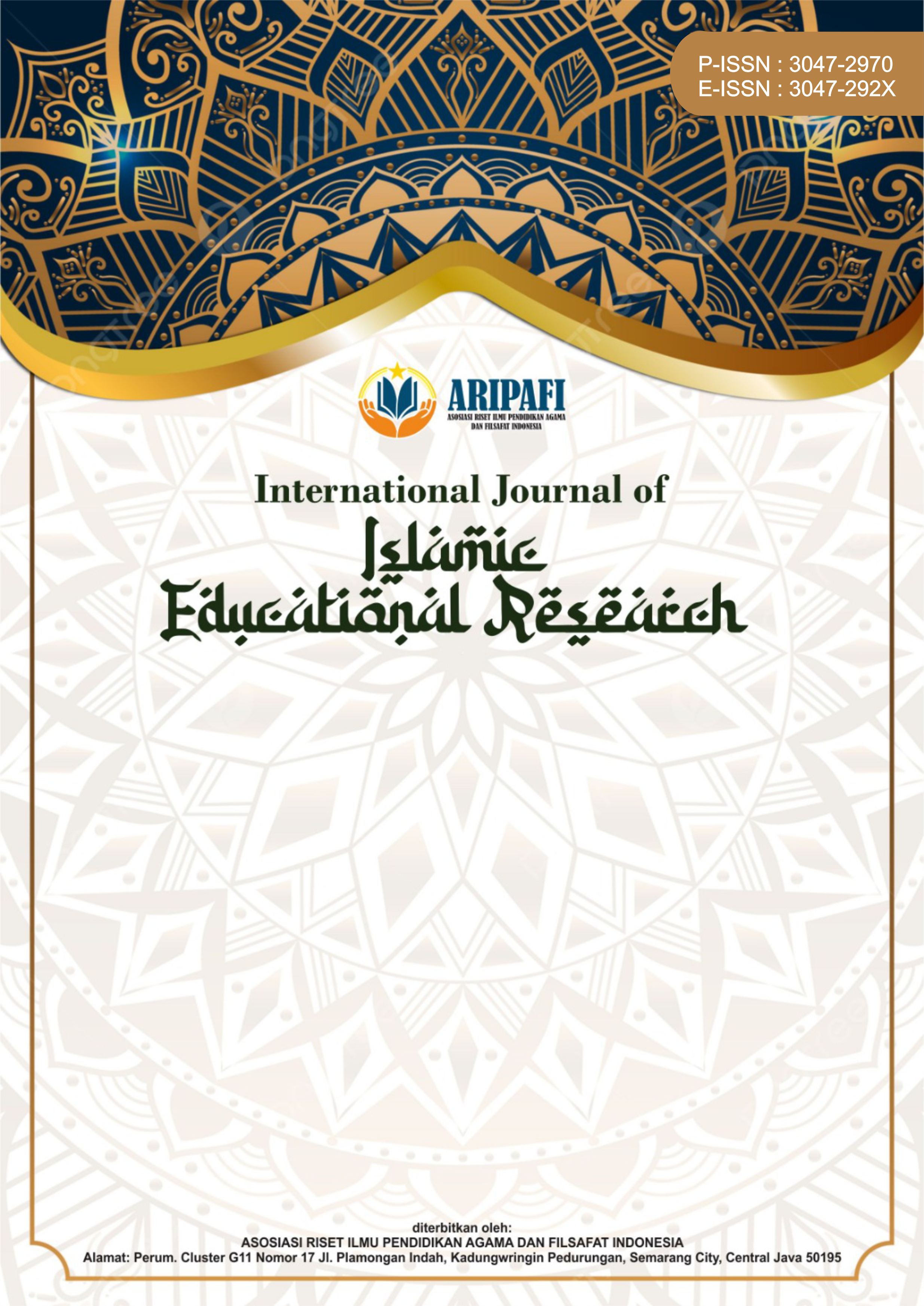Integration of Faith and Ecosystems: Islamic Theology as a Foundation for Resistance to Environmental Exploitation in Mandailing Natal
DOI:
https://doi.org/10.61132/ijier.v2i2.301Keywords:
Environmental Exploitation, Ecosystems, Islamic Theology, Local WisdomAbstract
This article examines the synergy between Islamic theological values and local wisdom as a basis for resistance to environmental exploitation in Mandailing Natal. The focus of the study lies on the application of faith principles, such as the concepts of khalifah, justice, and ihsan, and their implementation through the traditional practice of lubuk larangan. The literature study method was used to collect and analyze secondary data from scientific articles, journals, and national and local news sources. The results of the study show that these Islamic theological values have been deeply rooted in the culture of the Mandailing Natal community, encouraging a critical attitude towards illegal gold mining practices that damage the ecosystem. The lubuk larangan tradition also acts as a mechanism for social control and environmental conservation, by implementing periodic restrictions on extractive activities to provide space for natural regeneration. The findings indicate that the integration of Islamic theology and local wisdom results in a more integrated and ethical natural resource management paradigm. This research recommends strengthening the synergy of faith values and local traditions in the formulation of public policies and increasing community participation in environmental monitoring. This integrative approach can be used as a strategic model to overcome the challenges of environmental exploitation amid increasingly complex global dynamics.
References
Alimin, N. S. N. B., Awang, S. R. B., Ahmad, T., Safar, J., & Nain, S. M. (2018). Trustworthiness: The core of leadership in Islam. SHS Web of Conferences, 56, 03002. https://doi.org/10.1051/shsconf/20185603002
Brockelman, P. (2016). With new eyes: Seeing the environment as a spiritual issue. In J. E. Carroll, P. Brockelman, & M. Westfall (Eds.), The greening of faith: God, the environment, and the good life (20th Anniv., pp. 30–43). University of New Hampshire Press. https://core.ac.uk/download/pdf/215537928.pdf
Creswell, J. W., & Creswell, J. D. (2018). Research design: Qualitative, quantitative, and mixed methods approaches (5th ed.). Sage Publications. https://lccn.loc.gov/2017044644
Dawadi, S. (2020). Thematic analysis approach: A step-by-step guide for ELT research practitioners. Journal of NELTA, 25(1–2), 62–71. https://doi.org/10.3126/nelta.v25i1-2.49731
He, S., Yang, L., & Min, Q. (2020). Community participation in nature conservation: The Chinese experience and its implication to national park management. Sustainability, 12(11), 4760. https://doi.org/10.3390/su12114760
Lubis, T., Siregar, A. K., & Hasibuan, M. (2021). Tradition lubuk larangan as a local wisdom for ecocultural tourism river management through landscape anthropolinguistic approach in Mandailingnese. IOP Conference Series: Earth and Environmental Science, 926(1), 012029. https://doi.org/10.1088/1755-1315/926/1/012029
Omoyajowo, K., Chima, N. O., Okey, A. A., Johnson, A. R., Adesola, B. A., & Wang, Q. (2023). Exploring the interplay of environmental conservation within spirituality and multicultural perspective: Insights from a cross-sectional study. Environment, Development and Sustainability, 26(7), 16957–16985. https://doi.org/10.1007/s10668-023-03319-5
Osman, A. (2019). The Qurʾan and the Hadith as sources of Islamic law. In K. A. El Fadl, A. A. Ahmad, & S. F. Hassan (Eds.), Routledge handbook of Islamic law (Vol. 47, No. 2, pp. 125–140). Routledge. https://doi.org/10.4324/9781315753881-8
Pahrudin, H. M., Muhammad, H. A., Suhendri, & Elviria, S. (2023). Mengatasi problem sosial penambangan emas ilegal melalui segitiga kebijakan di Kabupaten Merangin, Jambi. Jurnal Government Innovation, 5(2), 251–270. https://doi.org/10.36636/jogiv.v5i2.3025
Rasyad, R. (2022). Konsep khalifah dalam Al-Qur’an (Kajian ayat 30 surat al-Baqarah dan ayat 26 surat Shaad). Jurnal Ilmiah Al-Mu’ashirah, 19(1), 20–31. https://doi.org/10.22373/jim.v19i1.12308
Redi, A. (2023). Responsive law enforcement in preventing and eradicating illegal mining in Indonesia. Journal of Law and Sustainable Development, 11(8), e1436. https://doi.org/10.55908/sdgs.v11i8.1436
Rohman, A., Hartiwiningsih, & Rustamaji, M. (2024). Illegal mining in Indonesia: Need for robust legislation and enforcement. Cogent Social Sciences, 10(1). https://doi.org/10.1080/23311886.2024.2358158
Rosadi, A., Anwar, S., & Ruhendi, A. (2021). The concept of justice in Qur’an and Hadith. Asy-Syari’ah, 23(1), 179–190. https://doi.org/10.15575/as.v23i1.9520
Simbolon, R. P. (2025, February 28). Rusak lingkungan, warga Siulangaling tolak aktifitas tambang di Sungai Parlampungan. Top Metronews. https://topmetro.news/108478/masyarakat-muara-batang-gadis-tolak-tambang-emas-ilegal/
Siregar, A. K., Tobroni, T., & Faridi, F. (2023). Pembentukan manusia ihsan dan karakter rabbani dalam Al-Qur’an. Edukasi Islami: Jurnal Pendidikan Islam, 12(1), 1219–1232. https://doi.org/10.30868/ei.v12i001.5940
Syahren. (2025, January 30). Warga Rantonalinjang tolak aktivitas tambang emas di kawasan hutan lindung. Warta Mandailing. https://wartamandailing.com/2025/01/30/tambang-emas-ilegal-di-hutan-lindung-cemari-sungai-warga-rantonalinjang-protes/
Wani, N. H. (2024). Harmony with creation: Exploring Islamic ecological principles and environmental ethics. Journal of Novel Research in Innovation and Development, 2(5), a259–a268. https://tijer.org/jnrid/papers/JNRID2405031.pdf
Worlanyo, A. S., & Jiangfeng, L. (2021). Evaluating the environmental and economic impact of mining for post-mined land restoration and land-use: A review. Journal of Environmental Management, 279, 111623. https://doi.org/10.1016/j.jenvman.2020.111623
Zulfahmi, Z. (2025). Harmonization of customary law and Islamic law in the management of forbidden lakes in village communities. Journal of Social Studies and Education, 2(2), 70–82. https://serambi.org/index.php/jsse/article/view/655
Downloads
Published
How to Cite
Issue
Section
License
Copyright (c) 2025 International Journal of Islamic Educational Research

This work is licensed under a Creative Commons Attribution-ShareAlike 4.0 International License.





